 All Culinary Chronicles
All Culinary Chronicles
Caviar
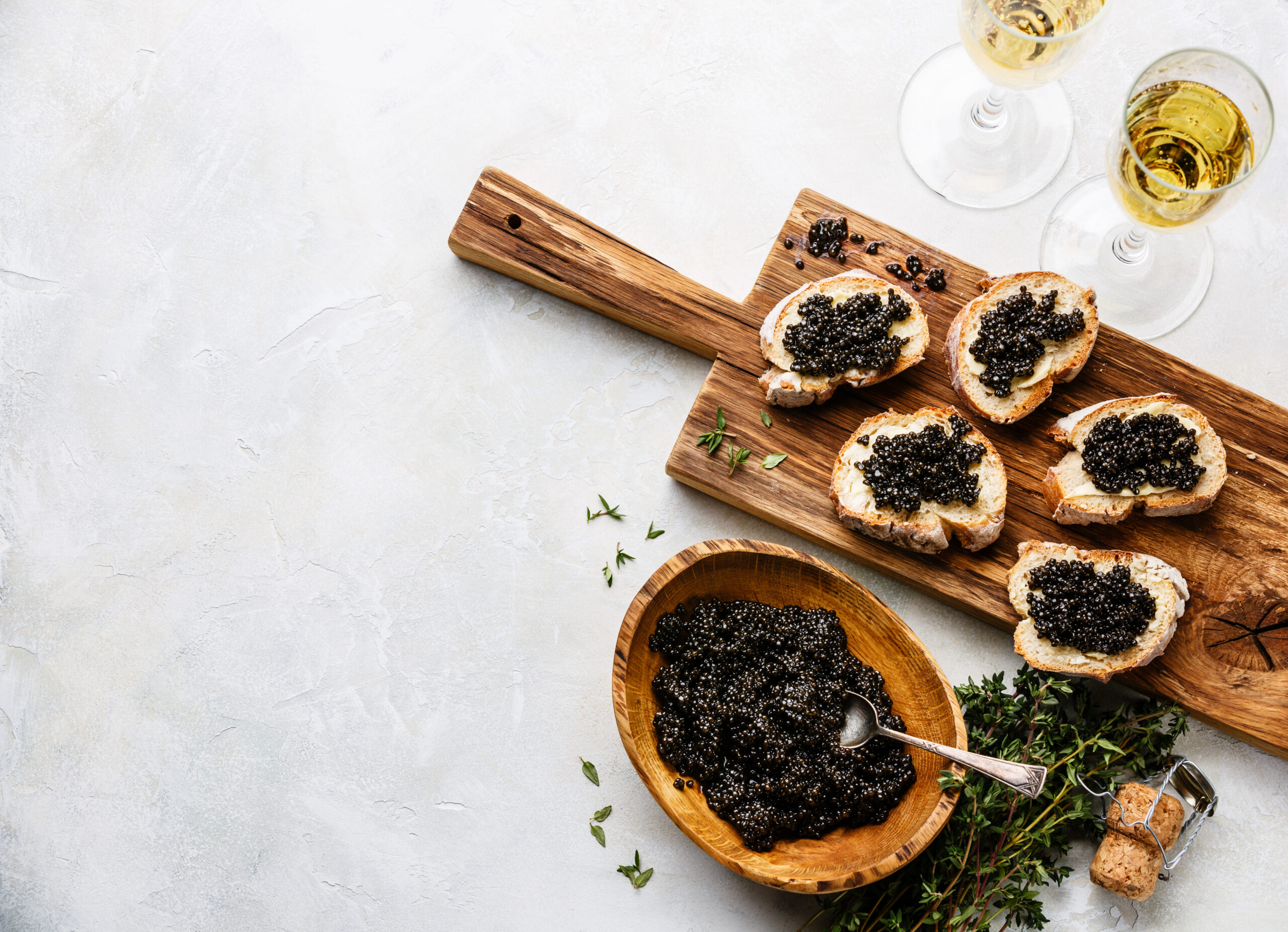
Luxurious, savory caviar is a sought-after delicacy, and the perfect indulgence for any holiday or anniversary.
Did You Know?
Eating a spoon-full of caviar for New Year’s is considered good luck in Europe, as the fish eggs are a symbol of fertility, abundance and health.
Caviar and Roe
All fish eggs are ‘roe’, but not all roe is caviar. Roe, in its true definition, is any fully ripe, unfertilized egg from a marine animal. It could refer to the ‘roe’ of a shrimp or the ‘roe’ of a crab as easily as it could the ‘roe’ of a fish. However, the use of the word ‘roe’ in the general consciousness of the public refers to the salt-cured eggs of any fish. Technically, even caviar is considered ‘roe’ until it is cured! Common types of fish roe come from salmon, trout, paddlefish, capelin (where masago comes from), and the Japanese flying fish cheilopogon agoo (where tobiko comes from).

Caviar are the unfertilized, salt-cured eggs of the sturgeon fish. There are a least 9 different species of sturgeon that caviar can come from: Beluga, Osetra, Sterlet, White, Amur, Siberian, Kaluga, Hackleback, and Sevruga, but Beluga and Osetra are considered the ‘True Sturgeons’. The designation as caviar producing species has expanded to the others as popularity and demand for the delicacy has grown. Each species has their own unique flavor profile depending upon environmental differences, diet, and health of the fish, but the most important determining factors of flavor profile is the age. The best caviar comes from the older, more mature fish. Quality caviar will have the appearance of perfect little beads, with no mushiness or excessive oiliness. The will ‘pop’ in your mouth, their silky smoothness giving way to a burst of buttery, nutty salinity.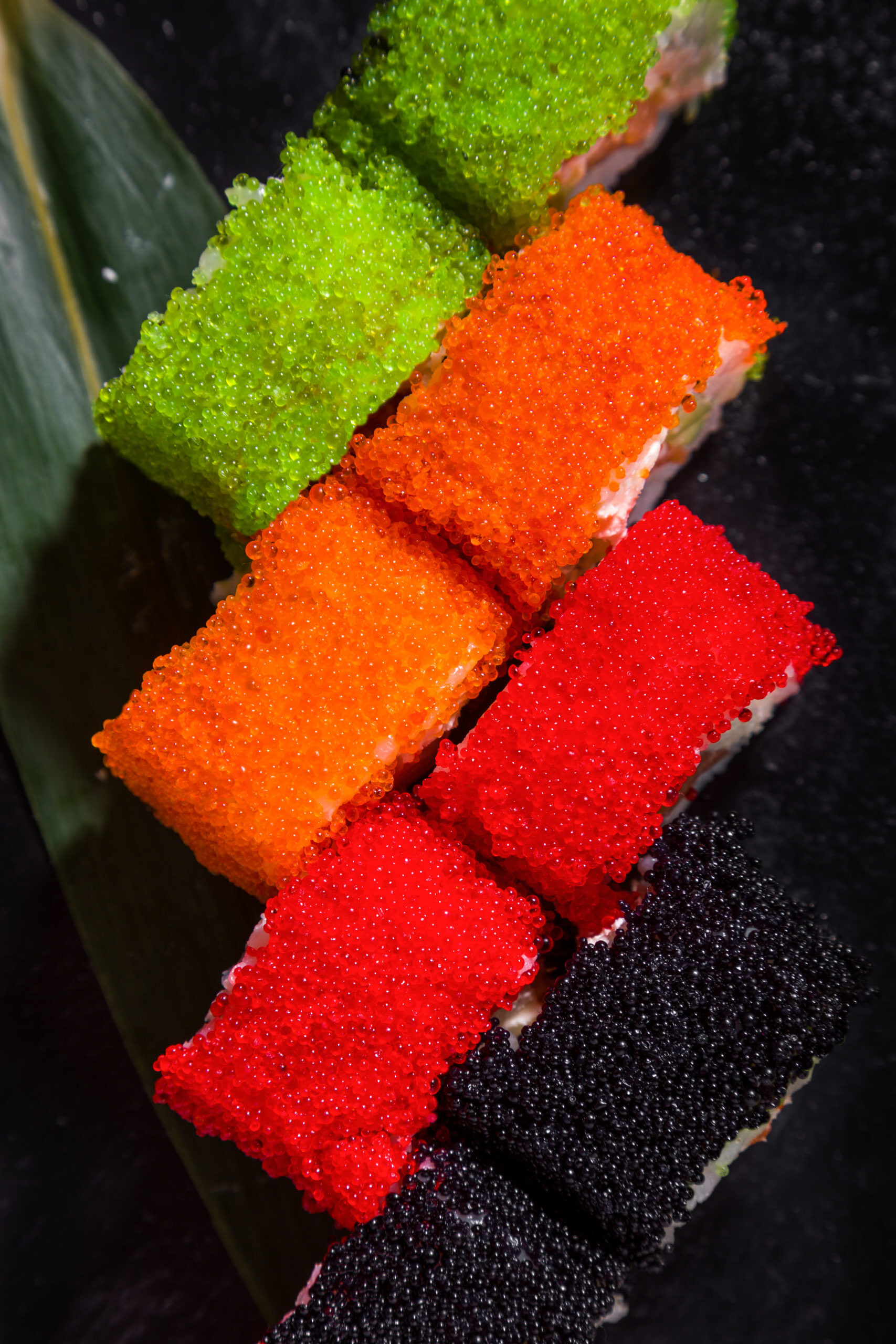
Tobiko & Masago
Much smaller than any traditional caviar or roe, tobiko is harvested from the Japanese flying fish. The eggs naturally come in a neutral golden hue and have a slightly crunchy, mild texture. The flavor profile of the tobiko are influenced by the natural dyes used in processing them. Tobiko colored orange or red comes from the use of beet juice or chilies as a dye. Beetroot-colored tobiko leans toward a sweeter flavor profile, while chili-dyed eggs pack a little more heat. Squid ink is used to create the black version of tobiko which has a savory, umami flavor. There is also yellow tobiko, made with yuzu infusing the eggs with a citrus, ginger taste, and green tobiko, made with a myriad of ingredients including mirin, vinegar, soy, and wasabi for a spicy version.
Lastly, masago is the roe from the Capelin, or smelt. This is a tiny fish swimming in the Atlantic and Artic seas- in fact, the Japanese word “masa” means sand, which is a reference to how small the roe from this fish is- as small as a grain of sand! These roe are a similarly light golden color to that of the Japanese flying fish tobiko comes from. Just like tobiko, masago is dyed before being packaged, though the colors are limited to orange, red, and black. Unlike other kinds of roe, crispy, mild flavored masago tends to have a sticky, almost clumpy consistency. This makes it easier to stick to food, and it is often used in sushi and sashimi.

How to Properly Serve Caviar
- Always serve caviar cold, but never freeze it. Keep the caviar refrigerated between 26-32˚ until you are ready to serve it, and optimally over ice when on the table.
- Never serve it in, near, or with metal. Metal will spoil the purity of the salty flavor of the eggs. Instead, opt for a porcelain, glass, or crystal dish. For a serving spoon, aim to use a mother-of-pearl, bone, horn, or gold spoon. Plastic spoons may be used, but they should be a last resort.
- Texture is king: do not spread or crush caviar. The enjoyment of letting the roundness of the eggs roll onto your palate and burst with flavor is key to the experience.
- Pairing: traditional caviar lovers counsel a sip of crisp vodka before trying a delicate, plain spoonful of the caviar globes. This preparation of the palate is supposed to allow the full pleasure of the caviar’s vibrant flavor to roll over your taste buds. A newer fad is to substitute the vodka with a crisp white wine or Brut Champagne.

Varieties of Caviar
Plaza Osetra Gold Malossol
Draeger’s is proud to offer this delicacy. This is not the inexpensive Costco version- this is the real, incredible, high-quality Gold roe. These pearl couscous-sized globes come from sturgeon caught off the coast of Greece and have a brilliant golden-amber hue. They are prized for their rich, creamy, nutty finish. Sought after worldwide, this is a caviar for kings.
Food Pairing Suggestions: Alone; Crème Fraiche, blini
Drink Pairing Suggestions: Vodka, Brut Champagne
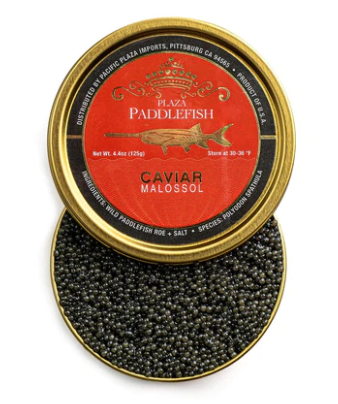
Plaza Wild Paddlefish Malossol
Paddlefish are native to the Mississippi River Basin right here in North America. Silky smooth, this roe comes exclusively from wild, line-caught fish and has become a favorite of innovative chefs and foodies. The medium-sized eggs range in color from pale-gray to dark ash and have a delicately briny, slightly bitter taste.
Food Pairing Suggestions: Deviled Eggs, Cucumber Dill Yogurt Bites, Linguine Pasta
Drink Pairing Suggestions: Vodka, Champagne, Pinot Grigio, White Burgundy

Plaza Wild Salmon Roe
Vibrant orange in color, these large-grain sized roe come from wild, line-caught salmon fished from the Pacific Northwestern Ocean. They have a subtle ‘pop’ on the palate buffeted by a clean yet intensely briny flavor.
Food Pairing Suggestions: Fondant Potatoes, Rice Bowl, Smoked Salmon Mousse
Drink Pairing Suggestions: Vodka, Champagne, American Sauvignon Blanc, Pilsner

Plaza Trout Roe
Gorgeous bright orange in color, the Plaza Trout Roe is a medium-sized granule with a firm shell. It delivers a fantastic ‘pop’ in the mouth with a sweet, slightly briny finish. This roe pairs particularly well with herbaceous and lemony dishes.
Food Pairing Suggestions: Lemon Herb Sour Cream, Buttered Scrambled Eggs, Vegetable Latkes
Drink Pairing Suggestions: Vodka, Champagne, Dry Rose
Label Knowledge: Malossol
From the way ‘malossol’ is on the jars, one might expect it to be a geographic region, but ‘malossol’ refers to the way the fish roe itself is cured. Malossol means ‘lightly salted’ in Russian. It is a way of achieving the perfect balance between salting to preserve the roe without stripping away its flavor and texture. Other preservations methods- salted (or semi-preserved), or payusnaya (pressed) contain more salt, which can overpower the natural flavor of the caviar pearls. Of all the ways the roe might be processed, the malossol process yields intricate flavor and by expert standards is used to produce the best caviar in the world.
Caviar Bar
True, the purists enjoy caviar by itself. But accompaniments to caviar have become a hit sensation within the foodie world. Caviar bars are popping up nationwide, doing a ‘bump of caviar’ has become a social trend! These are just a few recommendations to include in your own caviar bar.


Base: The traditional blini (mini pancake) can be supplemented with a variety of other types of ‘bases’ for your caviar to shine upon. Toast points, unsalted crackers, Ruffles potato chips, and cucumber slices are a few other excellent base options.
Accoutrements: This is a broad category, and there really is no right or wrong, other than to remember the caviar should be the star flavor. Too much of any one extra flavor can potentially overwhelm the experience of the roe.
Cheeses: The point of pairing cheeses is to enjoy the two different textures, the cheese with its creamy sold consistency and the ephemeral ‘pop’ of the pearls is a very unique experience. Choose very mild, buttery cheeses like Brie, mascarpone, Camembert, Fontina, and Comte.
Other Dairy: Traditionally, if caviar is not being savored alone, it is eaten atop a blini with crème fraiche. Similar to sour cream, crème fraiche is a thick cultured cream with a nutty, tangy and slightly sour flavor. A tiny dollop of crème fraiche is an excellent pairing to the salinity of caviar pearls. Sour cream is another great option to put out, both are very similar in flavor profile, but sour cream is a little more liquid in consistency. One or both should absolutely be included in a caviar bar. Butter is another dairy option. Caviar pearls are well accented with a cool, creamy unsalted butter.
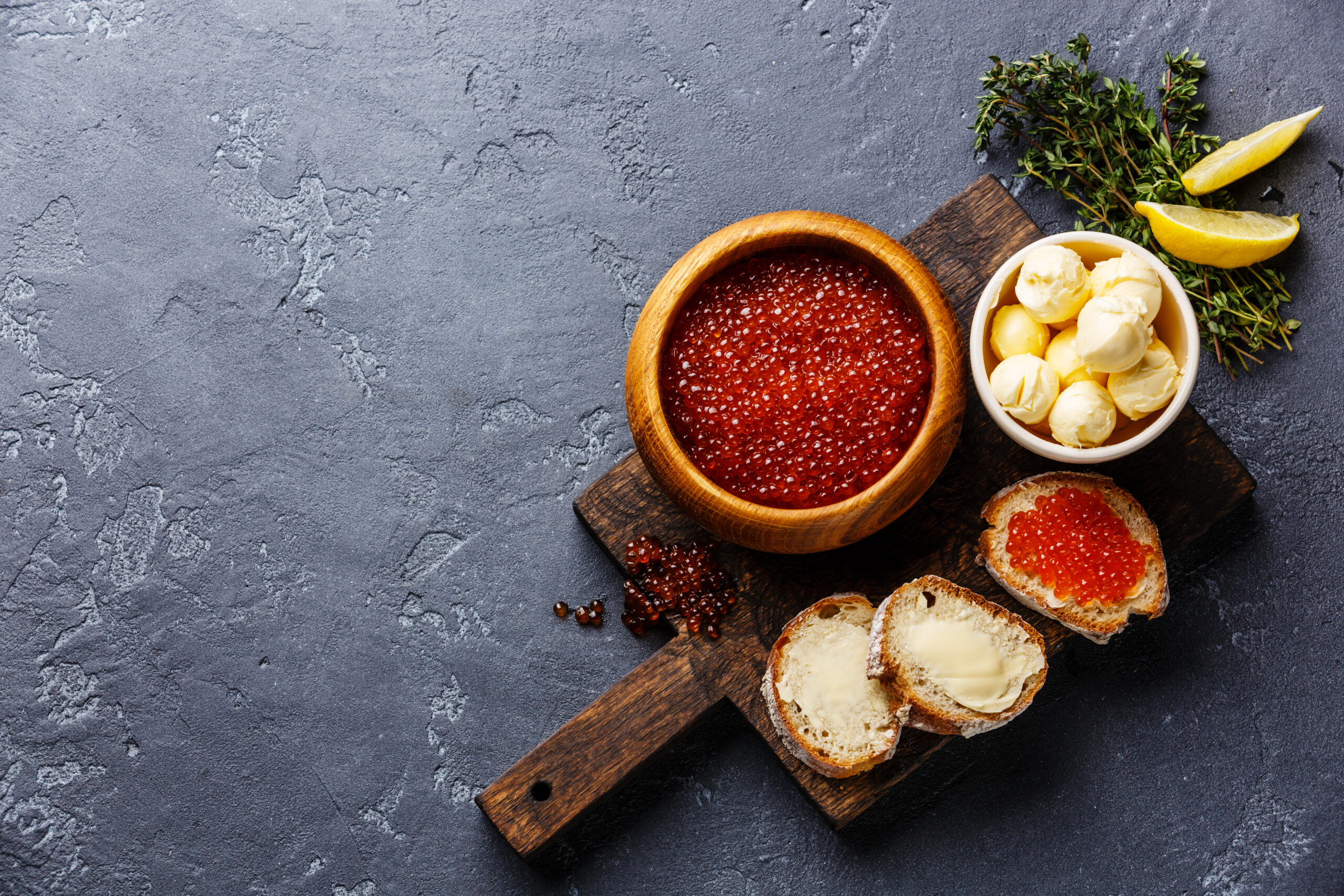

Fruit: Lemon is the number one fruit paired with caviar. The citrus pairs well with the salt, so wedges of lemon are great to have on hand. The truth is, most fruit- with the exception of avocados- don’t pair particularly well with the salinity of caviar. What fruit is nice for, however, is a pop of color to the table. Consider putting grapes, apple slices, pear slices, or strawberries nearby, but not necessarily as a part of, your caviar bar.
Vegetables: Cucumbers make the list twice! These mild, unassuming vegetables are a perfect vehicle for savoring the flavor of caviar. Fried zucchini, potato pancakes, and finely chopped red onion are all great pairing ideas, although they fall more into the realm of appetizers with caviar rather than ingredients to include in a caviar bar.
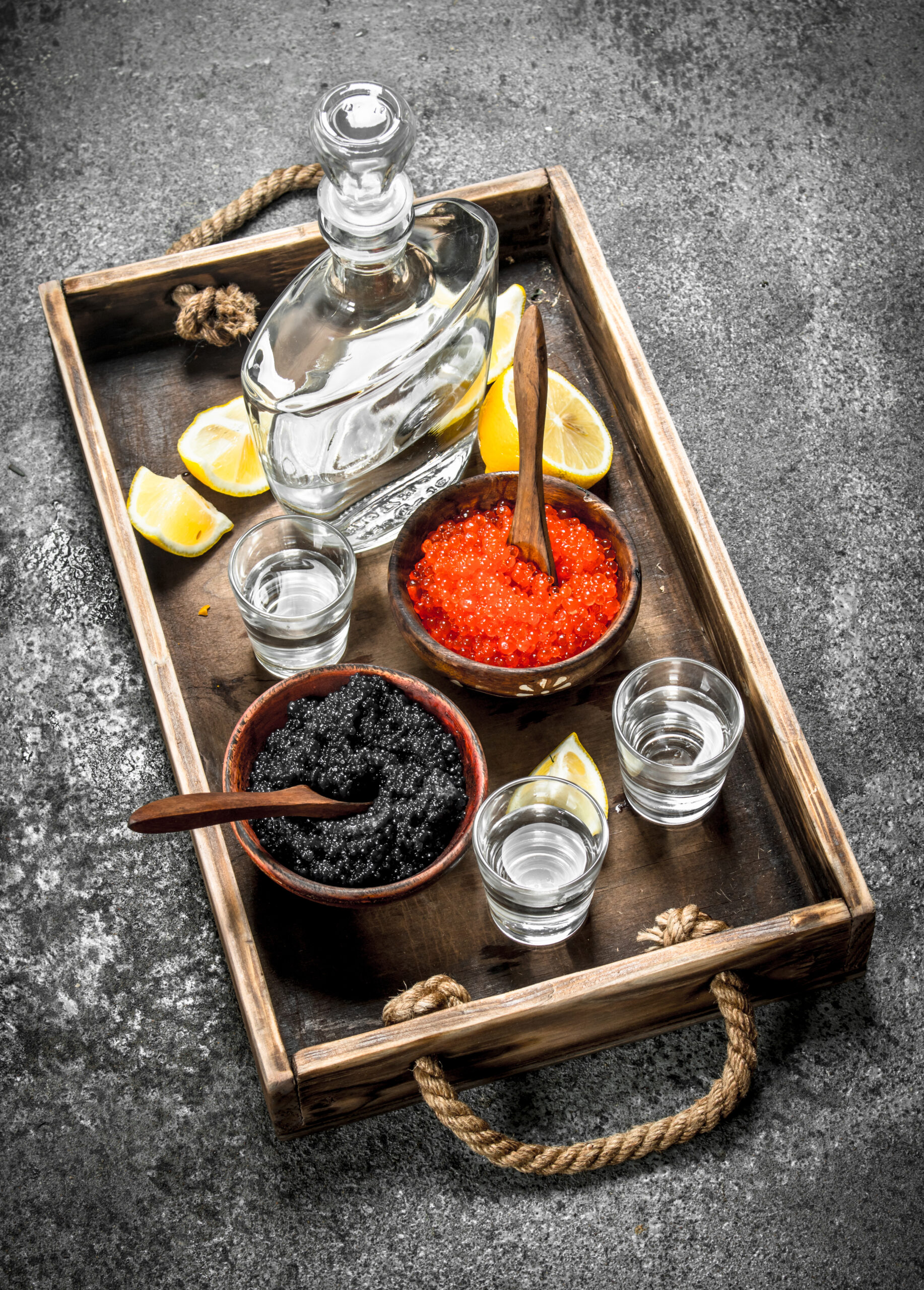
Herbs: Freshly chopped herbs can be a refreshing and fun to include in a caviar bar. The list is practically endless: chopped parsley, dill, chives, tarragon, oregano, fennel, thyme, basil, and cilantro. A small dish with each would be a fun way to add lots of choice and variety, not to mention color, to a caviar bar.
Beverages: Purists will always defer to chilled vodka as the best drink pairing for caviar. This is because vodka cleanly cuts through the salty fattiness of the caviar pearls, refreshing your palate for an unforgettable flavor experience with each new bite. Look for a vodka with a wheat or a rye-based vodka like Belvedere, Grey Goose, Chopin Wheat, Purity, Neft, or Meili. But vodka is not the only pairing for caviar; Champagne is another wonderful partner. A drier Champagne like Billecart-Salmon Brut, Pol Roger Brut, Taittinger Brut, or Dom Perignon Brut are the right fit to balance the salinity of the caviar beads.
A Flight of Taste Pairings
For a very different caviar bar, you could prepare a tasting flight of different caviars with different champagnes and wines. Pair a Blanc de Noir with the buttery Osetra Gold to offset the richness of the bright pearls, a Pinot Grigio like the classic Santa Margherita with its light, vibrant body is delicious with the large, lustrous Paddlefish pearls. With the salmon roe, pair a Blanc de Noir like that from Schramsberg made with red grapes- it has slightly more body and fruit, but the more robust flavors of the salmon make the pairing well worth it. Lastly, with the trout roe, pair a dry Brut Rosé, like that from Billecart-Salmon. Something lean and toasty with effervescence to balance the smoky trout.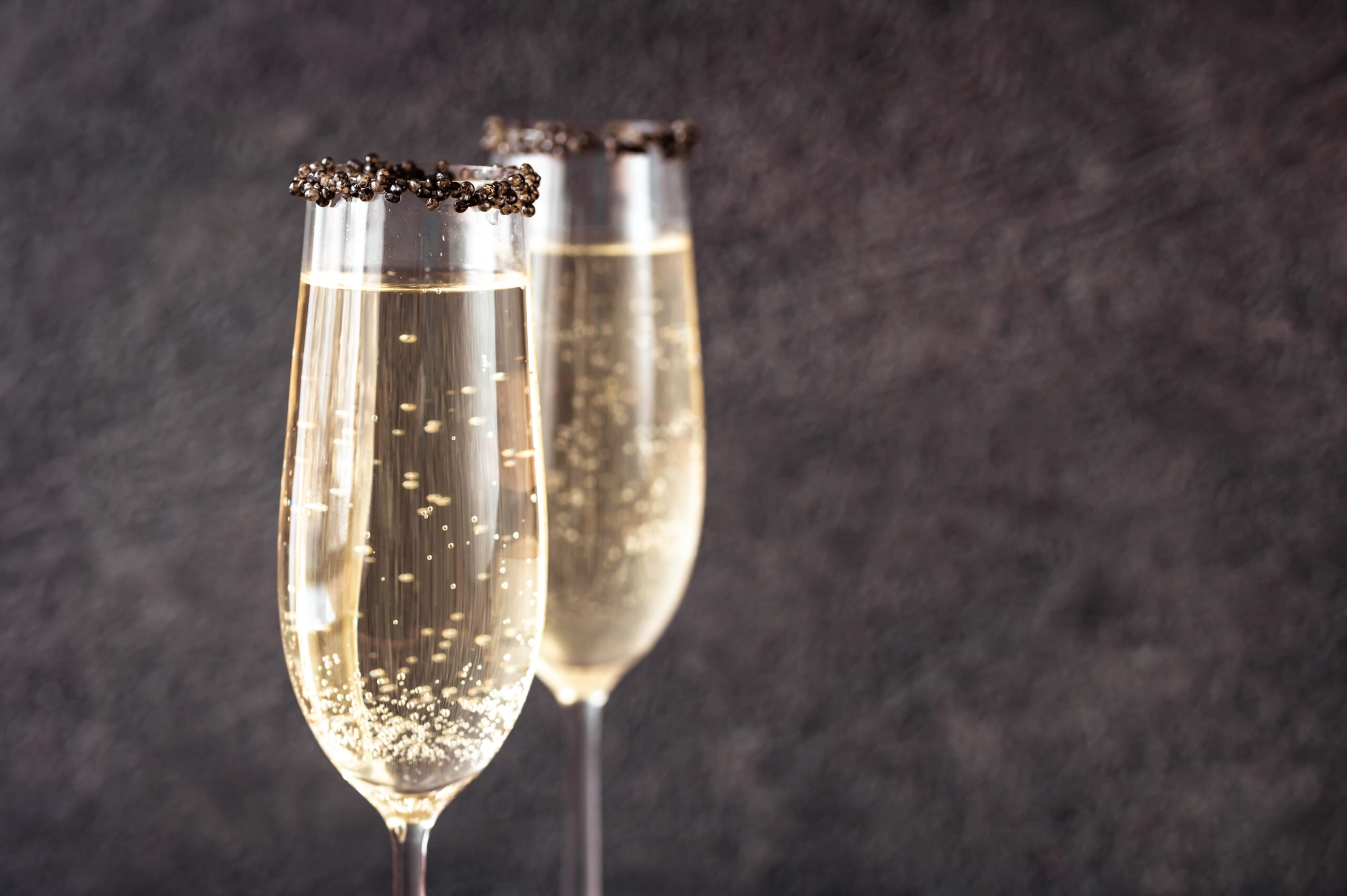
Fun Fact:
Just like lobster, caviar used to be considered a poor man’s food. But unlike caviar, lobster is considered bad luck for New Years! Apparently a crustacean that swims backwards does not bode well for the future!